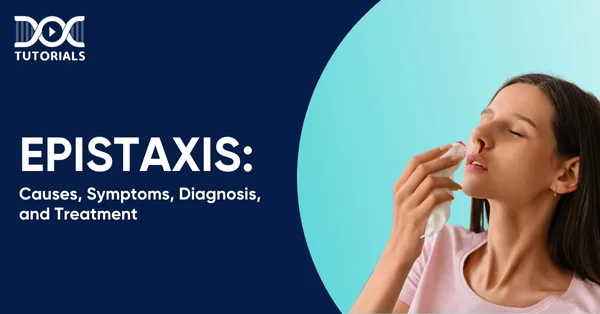Epistaxis: Causes, Symptoms, Diagnosis, and Treatment

Epistaxis, or nosebleeds, is bleeding from the nostrils caused by the rupture of small blood vessels in the nasal mucosa. Although usually harmless and self-limited, epistaxis can indicate various underlying medical conditions that must be diagnosed.
If you’re a medical student preparing for the NEET PG exam, it is crucial to thoroughly understand epistaxis. DocTutorials provides well-researched guides and high-yield study materials that make comprehension of such topics easier.
Keep reading to learn more about this condition, including its symptoms, causes, diagnosis, and treatment.
What is Epistaxis?
Commonly known as a nosebleed, epistaxis refers to bleeding from the nasal cavity due to the rupture of tiny blood vessels lining the nasal mucosa. This nasal bleeding typically involves one nostril and may be caused by sudden trauma, dry environment, infection, or systemic illnesses like clotting disorders and high blood pressure.
It could also be caused by medications such as anticoagulants. In general, most nosebleeds are harmless. However, recurrent or profuse bleeding could necessitate medical care, such as nasal packing treatments like anterior nasal packing or posterior nasal packing, to manage haemorrhage effectively.
What are the Causes of Epistaxis?
Certain local and systemic factors may cause epistaxis. Most nosebleeds are mild and unilateral, but it is essential to know the underlying causes and ensure they are appropriately managed.
Listed below are the common causes of epistaxis:
- Dry Air: The most frequent cause, particularly in dry, warm climates, high altitude, or air-conditioned indoor areas. Dry air dehydrates the nasal membranes, leading to fraying and bleeding.
- Nose Trauma: Nose picking, facial injuries, or objects inserted in the nose, especially in children.
- Infections and Inflammation: Upper respiratory infections, sinus infections, and rhinitis (allergic or non-allergic) can irritate the nose’s lining, leading to bleeding.
- Nasal Sprays Overuse: The prolonged use of antihistamines or decongestant nasal sprays may cause drying and damage to nasal tissues.
- Deviation of Nasal Septum: This is a structural anomaly that contributes to airflow turbulence, which can lead to dry irritation of the nasal mucosa.
- Chemical and Drug Exposure: Inhaling pungent fumes, chemical irritants, or illicit drugs such as cocaine can damage the lining of the nose.
- Anticoagulant Drugs: Aspirin, NSAIDs (nonsteroidal anti-inflammatory drugs), warfarin, and other blood thinners decrease clotting power and enhance the risk of bleeding.
- Systemic Diseases: Conditions like chronic hypertension, haemophilia, leukaemia, immune thrombocytopenia, and hereditary haemorrhagic telangiectasia can also lead to epistaxis or nose bleeding.
- Other Causes of Medical and Surgical Origin: Vascular changes related to pregnancy, facial/nasal surgeries, tumours, alcohol use, and nasal polyps may also be responsible for epistaxis.
What are the Risk Factors of Epistaxis?
The following are the key risk factors that can trigger the risk of epistaxis or nosebleed:
- Children Aged 2 to 10 Years: Since younger children have dry air from environmental conditions, get colds more frequently, have allergies, and have a propensity for placing their fingers or other objects in the nose, they tend to experience nosebleeds.
- Adults Aged 45 and Older: Older adults are at greater risk because they tend to have slower blood clotting. Other conditions that increase bleeding, including hypertension, atherosclerosis, and bleeding disorders such as haemophilia and Von Willebrand disease, are also more commonly found in older adults.
- Pregnant Women: Rapid hormonal changes and increased blood volume during pregnancy widen blood vessels in the nose, increasing the risk for injury and rupture.
- Individuals Taking Blood-Thinners: People consuming drugs, such as warfarin, aspirin, and other anticoagulant drugs, are at an increased risk for epistaxis.
- Individuals with Bleeding Disorders: Disorders such as haemophilia and Von Willebrand disease directly impair normal blood clotting and substantially increase the risk for epistaxis.
What are the Symptoms of Epistaxis?
Epistaxis or nosebleeds usually involve visible bleeding, but depending on the degree and cause of the bleeding, other symptoms may also occur.
Some common symptoms are:
- Bleeding from One or Both Nostrils: The majority of nosebleeds are from one nostril alone, but a more severe episode will occur from both. This can happen spontaneously or due to trauma, dryness, or an underlying condition.
- Bloody Drainage Down the Throat: For posterior epistaxis, blood can drain down the back of the throat, resulting in a foul taste, coughing, or nausea. This usually needs medical care and may require posterior nasal packing.
- Clots in the Nostrils: Blood clots can occur during or after a nosebleed. Though usually benign, regular or large clots need to be assessed by a medical practitioner.
- Persistent Bleeding Beyond 15–20 Minutes: If bleeding continues despite applying pressure or recurs frequently, it could indicate a more serious issue. In such cases, medical intervention like anterior nasal packing may be necessary.
- Other Symptoms: Symptoms such as dizziness, weakness, or facial trauma, along with a nosebleed, can point to other more serious diseases such as hypertension, clotting disorders, or injuries that need emergency treatment.
What is the Diagnosis of Epistaxis?
Accurate diagnosis is essential to identify the cause and guide appropriate treatment of epistaxis. Here are the major diagnostic procedures:
- Patient History Examination
When doctors determine that the patient is experiencing a nosebleed, they usually ask for a detailed history, including how long the nosebleed lasted, how often the nosebleed occurred, how much blood was lost with each nosebleed, and lastly, whether this seemed to be a nosebleed in either nostril or just one nostril.
Doctors also ask the patient about medications (especially blood thinners), a family history of bleeding disorders, and any use of nasal drugs or alcohol.
- Physical Examination
The ENT (ear, nose, throat) specialist inspects the inside of the nose using a nasal speculum and light source or an endoscope. The examination helps determine the bleeding site and provides evidence of trauma, dryness, or visible lesions that may produce bleeding.
- Nasal Preparation
For a better diagnosis, the healthcare provider might use topical anaesthetics and vasoconstrictors to anesthetise the area, slow the blood flow, and clear clots or crusts from the nasal passages.
- Imaging and Lab Tests
If the reason is not obvious, further studies such as X-rays, CT (computed tomography) scans, or lab tests might be performed to eliminate bleeding disorders, vascular defects, or tumours such as nasopharyngeal carcinoma.
What is the Treatment for Epistaxis?
Discussed below are the common treatment methods adopted in order to treat epistaxis or nosebleeds:
- Nasal Packing Procedure
Nasal packing involves putting gauze, special sponges, special foam, or inflatable balloons in the nose to pressure the bleeding and stop it. This process is divided into 2 types: anterior nasal packing and posterior nasal packing.
- Cauterisation
Cauterisation will be performed if a vessel that is causing the nosebleed is found. It can be cauterised by someone using silver nitrate or by a method of heat (also known as electrocautery). A local anaesthesia will be given to the patient to assist with the patient’s comfort level.
- Medications
Blood thinners might be reduced or ceased if those medications are the likely cause of the bleeding. However, it is common for high blood pressure-controlling drugs and clot-baby-inducing drugs like tranexamic acid to be prescribed.
- Foreign Body Extraction
If any foreign object within the nose, such as pebbles, beads, or food, causes epistaxis or a nosebleed, the doctor will carefully remove it.
- Surgery
Different surgical procedures, such as septoplasty, can be adopted in severe cases to stop nose bleeds.
- Ligation
If the patient suffers from nosebleeds profusely, the physician may elect to ligate (or tie off) the blood vessel responsible for the bleeding to permanently stop the bleeding.
FAQs About Epistaxis
- What questions should doctors ask a patient experiencing nosebleeds?
Doctors should ask about the details of the bleeding episode, such as the volume of blood, how long the nosebleed lasts, how often it occurs, and which side of the nose is bleeding. The physician also needs to determine if the nosebleed occurs with physical activity, during sleep, and whether it happens with a migraine.
- What factors increase the risk of nosebleeds?
Nasal growths, a perforated septum, uncontrolled hypertension, and certain nasal sprays each increase the incidence of nosebleeds.
- What is the most effective treatment for nosebleeds?
Cauterisation, nasal packing, or a combination of cauterisation and packing is effective for most patients with nosebleeds. Patients with frequent or severe bleeding that does not respond to medical options have surgical options available.
- Can a patient drink water after a nosebleed?
Yes, patients should consume plenty of fluids after suffering a nosebleed. Some effective choices are water, juice, and other non-caffeinated drinks. Drinking fluids will not impact a nosebleed.
- How to cure a nosebleed at home?
Most nosebleeds can be treated at home if you squeeze your nostrils together for 10 minutes or more and lean forward. This puts pressure on the branched vessel and clot formation.
Conclusion
Epistaxis is a widespread but potentially severe condition that requires a complete grasp of its aetiology, investigative strategy, and management. Understanding epistaxis is vital for those preparing for NEET PG since it covers anatomy, physiology, pathology, and clinical skills.
To simplify complicated topics like these, DocTutorials provides well-organised study materials for competitive examinations. Our targeted syllabus enables aspirants to tackle complex topics confidently with clarity, making preparation time-efficient and effective.
Join our NEET PG course at DocTutorials today!
Latest Blogs
-
-

NEET SS Exam 2024: Analysis, Key Dates, Counselling
The NEET SS 2024 exam kicked off on March 29, 2025. Over two days and two slots, candidates across 13…
-

NEET PG Registration 2025: An Essential Guide For Exam Prep
The NEET PG registration, which is conducted online, is a crucial step in the exam process. Filling out the NEET…





